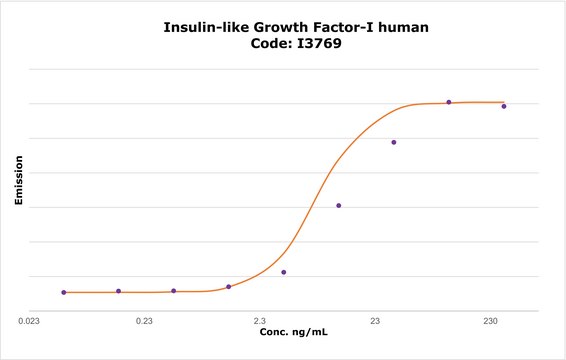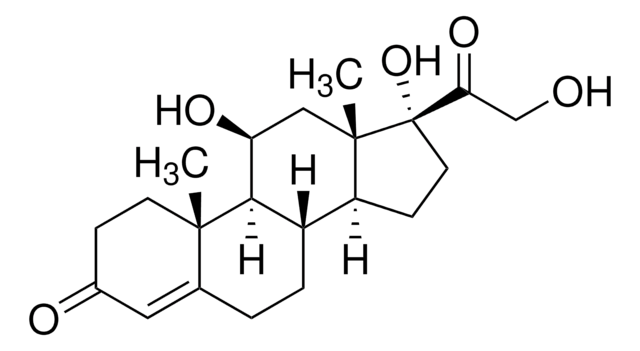I8773
Anti-Insulin-Like Growth Factor-I antibody produced in goat
affinity isolated antibody
Sign Into View Organizational & Contract Pricing
All Photos(1)
Synonym(s):
Anti-IGF-I
Recommended Products
biological source
goat
Quality Level
conjugate
unconjugated
antibody form
affinity isolated antibody
antibody product type
primary antibodies
clone
polyclonal
form
lyophilized powder
species reactivity
human
technique(s)
neutralization: 3-12 μg/mL
western blot: 0.1-0.2 μg/mL
UniProt accession no.
storage temp.
−20°C
target post-translational modification
unmodified
Gene Information
human ... IGF1(3479)
Related Categories
General description
Insulin-like growth factors -1 and -2 are important regulators of signalling that mediates growth and metabolism in cells. Insulin-like growth factor -1 shares structural homology with proinsulin and is mainly produced by liver. IGF-1 acts via specific receptor, IGF-1R, a heterodimeric tyrosine kinase receptor that signals to various second messenger pathways such as MAPK, Raf/Ras and PI3K cascades. The effect of IGF-1 is by endocrine, paracrine and autocrine signalling. The effects of IGF-1 signalling are important at many developmental levels from cells to organ to organism, growth, differentiation, anti-apoptosis, proliferation and transformation. Irregular IGF-1 signaling has been implicated in many cancers including melanoma, breast, lung, colon and prostate
Anti-IGF-I recognizes human insulin-like growth factor I. The antibody does not react with human IGF-II.
Anti-IGF-I recognizes human insulin-like growth factor I. The antibody does not react with human IGF-II.
Specificity
The antibody neutralizes the biological activity of recombinant human IGF-I.
Immunogen
recombinant human IGF-I expressed in Escherichia coli
Application
Anti- IGF-1 antibody may be used for neutralization reactions, the ND50 of the antibody is 3-12 μg/ml. For immunoblotting a working antibody concentration of 0.1-0.2 μg/ml.
Physical form
Lyophilized from a 0.2 μm filtered solution of phosphate buffered saline, pH 7.4, with 5% trehalose.
Preparation Note
Affinity isolated by IGF-I affinity chromatography.
Disclaimer
Unless otherwise stated in our catalog or other company documentation accompanying the product(s), our products are intended for research use only and are not to be used for any other purpose, which includes but is not limited to, unauthorized commercial uses, in vitro diagnostic uses, ex vivo or in vivo therapeutic uses or any type of consumption or application to humans or animals.
related product
Product No.
Description
Pricing
WGK
WGK 2
Flash Point(F)
Not applicable
Flash Point(C)
Not applicable
Personal Protective Equipment
dust mask type N95 (US), Eyeshields, Gloves
Regulatory Information
新产品
Certificates of Analysis (COA)
Search for Certificates of Analysis (COA) by entering the products Lot/Batch Number. Lot and Batch Numbers can be found on a product’s label following the words ‘Lot’ or ‘Batch’.
Already Own This Product?
Find documentation for the products that you have recently purchased in the Document Library.
Aimei Zhong et al.
Journal of cellular and molecular medicine, 18(7), 1257-1266 (2014-04-12)
True macromastia is a rare but disabling condition characterized by massive breast growth. The aetiology and pathogenic mechanisms for this disorder remain largely unexplored because of the lack of in vivo or in vitro models. Previous studies suggested that regulation
H Yu et al.
Journal of the National Cancer Institute, 91(2), 151-156 (1999-01-29)
Insulin-like growth factors (IGFs), in particular IGF-I and IGF-II, strongly stimulate the proliferation of a variety of cancer cells, including those from lung cancer. To examine the possible causal role of IGFs in lung cancer development, we compared plasma levels
J M Chan et al.
Science (New York, N.Y.), 279(5350), 563-566 (1998-02-07)
Insulin-like growth factor-I (IGF-I) is a mitogen for prostate epithelial cells. To investigate associations between plasma IGF levels and prostate cancer risk, a nested case-control study within the Physicians' Health Study was conducted on prospectively collected plasma from 152 cases
S E Hankinson et al.
Lancet (London, England), 351(9113), 1393-1396 (1998-05-21)
Insulin-like growth factor (IGF)-I, a mitogenic and antiapoptotic peptide, can affect the proliferation of breast epithelial cells, and is thought to have a role in breast cancer. We hypothesised that high circulating IGF-I concentrations would be associated with an increased
J Dupont et al.
Hormone research, 55 Suppl 2, 22-26 (2001-10-31)
The insulin receptor (IR) and the insulin-like growth factor I receptor (IGF-IR) belong to the same subfamily of receptor tyrosine kinases with two extracellular alpha-subunits and two transmembrane beta-subunits. They share a high similarity of structure and intracellular signalling events.
Our team of scientists has experience in all areas of research including Life Science, Material Science, Chemical Synthesis, Chromatography, Analytical and many others.
Contact Technical Service


